
Eremophila divaricata, also known as spreading emu bush, is a flowering plant in the figwort family, Scrophulariaceae and is endemic to Australia. It is a shrub with stiff, spreading, tangled branches which are often spiny on their ends, erect leaves and mauve to lilac-coloured flowers.
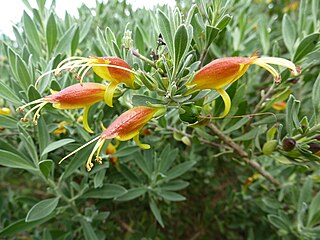
Eremophila glabra, commonly known as tar bush, is a plant in the figwort family, Scrophulariaceae and is endemic to Australia. It is sometimes a low, ground-hugging and sometimes an erect shrub. The leaves are variable in size and shape and there is a range of flower colours. In spite of its scientific name, not all forms of the plant are glabrous but most have many small, raised glands on the stems, flowers and leaves.

Eremophila oldfieldii, commonly known as pixie bush, is a flowering plant in the figwort family, Scrophulariaceae and is endemic to Western Australia. It is a shrub or small tree with rough bark, broad, flat or narrow fleshy leaves and red, orange or yellow flowers.

Eremophila oppositifolia, commonly known as weeooka, twin-leaf emu bush and mountain sandalwood, is a plant in the figwort family, Scrophulariaceae, and is endemic to Australia. It is a shrub or small tree with its leaves arranged in opposite pairs and has cream to red or sometimes maroon coloured flowers. It occurs in all mainland states, but not the Northern Territory.

Eremophila latrobei, commonly known as crimson turkey bush, native fuchsia, Latrobe's emu bush, grey fuchsia bush, warty fuchsia bush and Georgina poison bush is a flowering plant in the figwort family, Scrophulariaceae and is endemic to Australia. It is an erect, highly branched shrub with usually linear leaves and red to purple-red flowers and which occurs in all mainland states, including the Northern Territory but excluding Victoria.
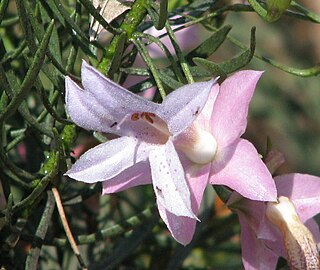
Eremophila abietina, also known as spotted poverty bush, is a plant in the figwort family, Scrophulariaceae and is endemic to a few arid areas of Western Australia. It is a stiff, upright, compact and very sticky shrub with distinctive, dark bluish-green leaves and pale coloured flowers spotted purple.

Eremophila bowmanii, also known as silver turkeybush, Bowman's poverty bush and flannel bush, is a flowering plant in the figwort family, Scrophulariaceae and is endemic to New South Wales and Queensland in Australia. It is a low to medium, spreading shrub with silvery-grey, hairy foliage and blue to lilac flowers, and sometimes grows in dense thickets with mulga.
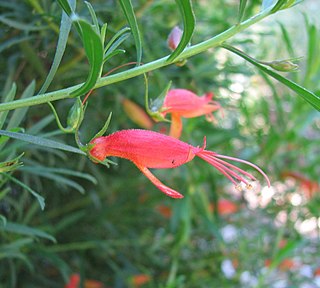
Eremophila decipiens, commonly known as slender fuchsia bush or narrow-leaved fuchsia bush is a flowering plant in the figwort family, Scrophulariaceae and is endemic to an area extending from the south-west of Western Australia to southern parts of South Australia. It is low, sprawling shrub with lance-shaped leaves and red, orange or yellow flowers on a long, S-shaped stalk.

Eremophila fraseri, commonly known as burra or jilarnu, is a flowering plant in the figwort family, Scrophulariaceae and is endemic to Western Australia. It is a shrub or small tree with all above-ground parts of the plant, apart from the petals, sticky and shiny due to the presence of a large amount of resin. The petals are coloured white, cream, pink and brown.

Eremophila deserti is a shrub which is endemic to Australia. Common names for this species include turkey bush, dogwood, poison bushEllangowan poison bush, pencil bush and carrot bush. It is common and widespread in all mainland states, although not the Northern Territory. Some forms are poisonous to stock.

Eremophila racemosa, also known as showy eremophila, is a flowering plant in the figwort family Scrophulariaceae, and is endemic to Western Australia. It is an erect shrub with glabrous leaves, small, green sepals and flowers that have many colour variations often changing as they age.

Eremophila densifolia is a flowering plant in the figwort family, Scrophulariaceae and is endemic to the south-west of Western Australia. It is usually a low, spreading shrub with densely clustered leaves and lilac to purple flowers.
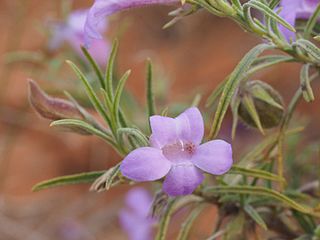
Eremophila gilesii, commonly known Charleville turkey bush, green turkey bush, desert fuchsia and Giles emu bush is a flowering plant in the figwort family, Scrophulariaceae and is endemic to Australia. It is usually a low, spreading shrub with pinkish-lilac to purple flowers and is widespread in the Northern Territory and all mainland states except Victoria. It is considered a difficult agricultural weed in some parts of Queensland but is often used as a bush medicine by Aboriginal people.

Eremophila goodwinii, commonly known purple fuchsia bush and Goodwin's emu bush is a flowering plant in the figwort family, Scrophulariaceae and is endemic to Australia. It is a small, spreading or erect shrub with most parts sticky due to the presence of resin, tapering leaves and pale lilac to mauve flowers. It occurs in New South Wales, the Northern Territory and Queensland.
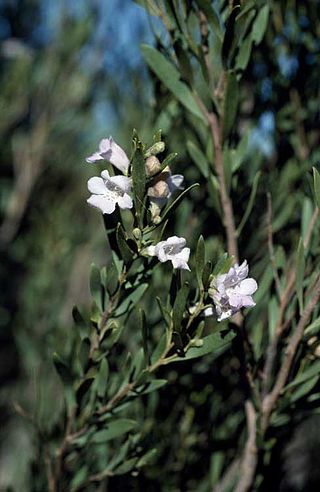
Eremophila paisleyi is a plant in the figwort family, Scrophulariaceae and is endemic to Australia. It is a rounded, broom-shaped shrub with white or lilac-coloured flowers which occurs in Western Australia, South Australia and the Northern Territory.

Eremophila parvifolia is a flowering plant in the figwort family, Scrophulariaceae and is endemic to Australia. It is a shrub which has small, usually egg-shaped leaves and blackish flower buds which open to purple flowers which are white with purple spots inside. There are two subspecies, both of which are found in Western Australia and one which is also found in South Australia.

Eremophila serrulata, commonly known as serrate-leaved eremophila, is a flowering plant in the figwort family, Scrophulariaceae and is endemic to Australia. It is an erect or spreading shrub whose leaves are sticky and have small serrations, and flowers that have green, yellowish-green or yellowish-brown petals.

Eremophila spectabilis, commonly known as showy poverty bush, is a flowering plant in the figwort family, Scrophulariaceae and is endemic to Western Australia. It is a dense, erect shrub with narrow, greyish leaves and blue, mauve or purple flowers.
Eremophila verrucosa is a flowering plant in the figwort family, Scrophulariaceae and is endemic to South Australia. It is an erect, broom-shaped shrub with its leaves and branches covered with yellow-grey scales and lilac to purple flowers.
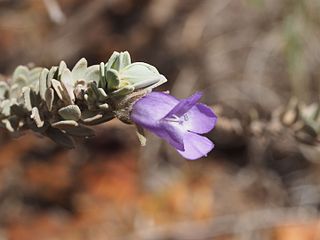
Eremophila jucunda subsp. pulcherrima is a plant in the figwort family, Scrophulariaceae and is endemic to Western Australia. It is a small shrub with grey, hairy leaves and sepals and blue or mauve flowers often growing in stony places. It is similar to subspecies jucunda but is distinguished from it by its grey new growth and more northerly distribution.





















